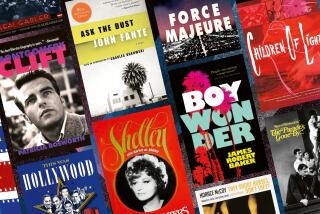Fellini: A LIFE by Hollis Alpert (Atheneum: $18.95; 326 pp., illustrated)
- Share via
Writing a biography about Federico Fellini is a difficult task in the ‘80s. Like other autobiographical film makers such as Bergman and Truffaut, Fellini has mythologized his life with such power that any biography is bound to pale in comparison. Moreover, so much has been written about Fellini that one wonders why another biography is needed.
Fellini is one of those directorial stars whose emergence in the ‘50s helped inspire the auteur theory, which defined the director as the primary “author” of the film, the artist whose vision and style leave a personal stamp on his works. “La Strada,” which brought Fellini to world attention and won him his first Oscar, was the film in which French critic Andre Bazin saw the “inspiration that connotes a true author.”
Unlike previous works on Fellini, Alpert’s biography claims to separate myth from reality, yet it cultivates a breezy journalistic style rather than scholarly rigor. His sources are segregated in the “Acknowledgments” so that his narrative is never ruptured by distracting footnotes. When Alpert does cite a source, he usually gives only the name, not the context (e.g., “When (screenwriter) Tullio Pinelli was once asked about Fellini’s relationship with women, he answered: ‘See the harem scene in 8 1/2; it’s like that.’ ”) (Pinelli, a Turin-born attorney and screenwriter, collaborated with Fellini on “La Dolce Vita” and “Nights of Cabiria.”) While acknowledging that Fellini frequently lies in his interviews and that his autobiographical works are “heightened by imagination and invention,” Alpert still draws heavily on them for his “facts.”
Alpert also claims that previous works on Fellini “had not been put together in any orderly biographical shape or form.” His biography begins in medias res with the 1959 premiere of “La Dolce Vita”--a film to which he devotes four (out of 22) chapters, yet without explaining why it was important historically. He even concludes: “Oddly, the film, viewed a quarter of a century after its birth, doesn’t seem fully to merit the amount of explication it has engendered.” Clearly he foregrounds this film because it marks the apex of Fellini’s success from which Alpert will trace his decline.
Surprisingly weak are Alpert’s 2 1/2 chapters on “8 1/2,” generally considered Fellini’s greatest and most influential work as well as his most explicitly autobiographical film. Choosing not to dwell on “the meanings” of Fellini’s films, Alpert instead provides superficial summaries of critical reactions, ranging, in the case of “8 1/2,” from the obtuseness of a daily reviewer like Judith Crist to the doubling mirror constructions of French semiotician Christian Metz. Not only do these summaries lead to banal conclusions (“the film became an intellectual cud to chew on”), they also prevent Alpert from adequately assessing the film’s historical significance.
Though weak on the finished films, Alpert is illuminating on Fellini’s collaborative process, particularly with other writers and with his mentor Roberto Rossellini. Alpert is also marvelously detailed on the projects that never made it to the screen. Increasingly he concentrates on Fellini’s financial troubles with producers, and here’s where Alpert’s ulterior design becomes most apparent.
What gradually emerges is the familiar story of another international auteur, like Erich Von Stroheim, Jean Renoir and Orson Welles, who, though acknowledged to have made some of the greatest films of all time, is still denied access to the medium when his films stop making money. Alpert seems reluctant to overemphasize this tragic dimension, perhaps because while Fellini is alive and directing, there’s still hope.
As a promising sign, Alpert quotes an executive of RAI, the Italian television firm which has financed four of Fellini’s recent commercial failures:
“We were always proud to be able to make a film with him, even though we sensed a change in the audience away from him . . . We knew about his money and producer problems, and, as an institution of society we thought it was our duty to help Fellini make the film.”
Alpert shares this sense of responsibility. That’s why, despite its many limitations, his biography is important. Not content to have spectators heed what Simon says and what Canby savages, Alpert is striving to make a critical intervention--to restore a tottering giant to his rightful place in film history.
More to Read
Only good movies
Get the Indie Focus newsletter, Mark Olsen's weekly guide to the world of cinema.
You may occasionally receive promotional content from the Los Angeles Times.







